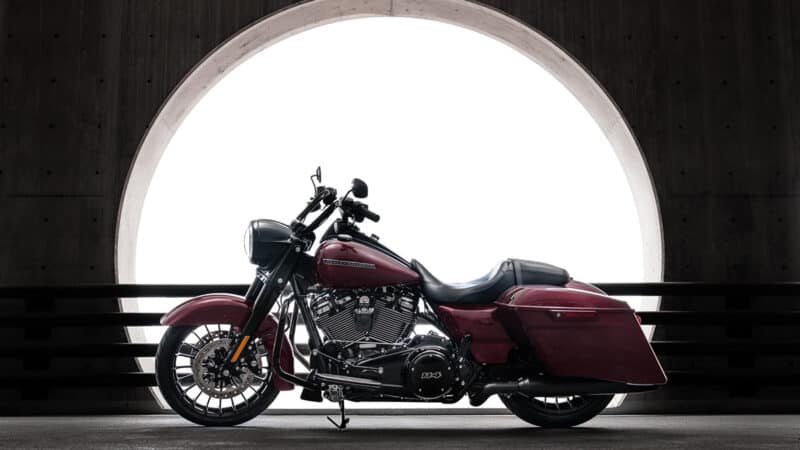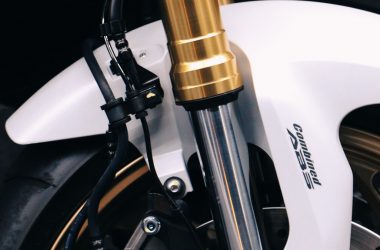Table of Contents Show
Changing your motorcycle engine oil is one of the crucial factors for your motorbike’s performance & it’s longevity. And there are 3 types of engine (motor) oils used in motorcycles that should be changed accordingly to maintain good engine health.
How Often Do You Need To Change Motorcycle Engine Oil?
Most people get confused regarding how often to change their motorcycle oil or motorcycle oil change interval and finally when to change the oil in their motorcycle.
- Mineral Engine Oil Change Interval: 2,000 Miles/3,000 Kilometers or (Once a year).
- Semi Synthetic Engine Oil Change Interval: 5,000-6,000 Miles/8,000-9,500 Kilometers or (Once a year).
- Fully Synthetic Engine Oil Change Interval: 7,000-10,000 Miles/11,000-16,000 Kilometers or (Once a year).
I have compiled a list of different types of motorcycles and their engine oil change intervals according to their CC and distance, So you can get a better idea of when you should change your motorcycle’s engine oil.
Different Types Of Motorcycles & Their Oil Change Intervals
There are different types of motorcycles and each one of them needs an engine oil change. But the oil change frequency changes depending upon the motorbike, how many miles/kilometers it traveled, engine oil types, and motorcycle’s specifications.
I have curated an easy-to-follow chart for different types of motorcycles and their engine oil change intervals considering crucial factors such as engine oil type, distance, specifications.
SPORTS
| CC | 250 – 500 | 600 – 1200 |
| FULLY SYNTHETIC OIL | MILES = 3,000 KILOMETERS = 5,000 | MILES = 6,000 KILOMETERS = 10,000 |
| SEMI – SYNTHETIC OIL | MILES = 2,500 KILOMETERS = 4,000 | MILES = 5,000 KILOMETERS =8,000 |
| MINERAL BASED OIL | MILES = 2,000 KILOMETERS = 3,000 | MILES = 2,500 KILOMETERS = 4,000 |
CRUISER
| CC | 500 – 999 | 1000 – 1800 | 2000+ |
| FULLY SYNTHETIC OIL | MILES = 5,000 KILOMETERS = 8,000 | MILES = 7,800 KILOMETERS = 12,500 | MILES = 10,000 KILOMETERS = 16,000 |
| SEMI – SYNTHETIC OIL | MILES = 3,000 KILOMETERS = 5,000 | MILES = 3,800 KILOMETERS =6,000 | MILES = 4,500 KILOMETERS =7,200 |
| MINERAL BASED OIL | MILES = 2,500 KILOMETERS= 4,000 | MILES = 3,000 KILOMETERS = 5,000 | MILES = 5,000 KILOMETERS = 8,000 |
ADVENTURE
| CC | 300 – 800 | 1000 – 1300 |
| FULLY SYNTHETIC OIL | MILES = 6,000 KILOMETERS = 10,000 | MILES = 8,000 KILOMETERS = 13,000 |
| SEMI – SYNTHETIC OIL | MILES = 5,000 KILOMETERS = 8,000 | MILES = 6,000 KILOMETERS =10,000 |
| MINERAL BASED OIL | MILES = 4,000 KILOMETERS = 6,500 | MILES = 5,000 KILOMETERS = 8,000 |
STREET
| CC | 150 – 300 | 350 – 600 | 650 – 1200 |
| FULLY SYNTHETIC OIL | MILES = 3,500 KILOMETERS = 6,000 | MILES = 3,000 KILOMETERS = 5,000 | MILES = 6,000 KILOMETERS = 10,000 |
| SEMI – SYNTHETIC OIL | MILES = 2,800 KILOMETERS = 4,500 | MILES = 2,500 KILOMETERS =4,000 | MILES = 5,000 KILOMETERS =8,000 |
| MINERAL BASED OIL | MILES = 2,200 KILOMETERS= 3,500 | MILES = 2,000 KILOMETERS = 3,000 | MILES = 2,500 KILOMETERS = 4,000 |
OFF- ROAD
| CC | 125 – 240 | 250 – 500 |
| FULLY SYNTHETIC OIL | HOURS = 4 TO 15 OR AFTER EVERY RACE | HOURS = 6 TO 15 OR AFTER EVERY RACE |
| SEMI – SYNTHETIC OIL | HOURS = 4 TO 10 OR AFTER EVERY RACE | HOURS = 6 TO 10 OR AFTER EVERY RACE |
| MINERAL BASED OIL | HOURS = 2 TO 6 OR AFTER EVERY RACE | HOURS = 3 TO 8 OR AFTER EVERY RACE |
Fully synthetic/synthetic and semi-synthetic are highly clarified and concentrated oils with strong chemical bonds, where semi-synthetic is a mixture of synthetic and mineral oils. Synthetic oils have high heat, load & stress tolerance and provide less friction between the engine components. Mineral-based engine oils on the other hand are less refined and concentrated with weak chemical bonds causing oxidization and breakage of the chemical properties in the oil under high engine temperatures.
For the longevity of your motorcycles stick with fully synthetic or semi-synthetic engine oils for your Race / Track days. Due to the demanding nature of higher CC motorcycles, you should stick with synthetic oils.
As people tend to ride at higher speeds for a prolonged time or under harsh conditions, you need to have an engine oil that can protect your motorcycle from unwanted damages.
As mineral-based engine oils are less tolerant they tend to lose their chemical properties under challenging conditions way earlier than synthetic oils. You can use mineral-based engine oils for your lower CC motorcycles if you don’t race or just use your motorcycle for commuting purposes. As mineral oil lacks strong chemical bonds, it is not optimal under high engine temperature for those whose riding styles are competitive or demanding.
What Happens If Engine Oil Is Not Changed In Motorcycle
A routine engine oil change keeps the motorcycle and it’s moving components integrity, which will keep your daily commute or group riding experience at its peak without causing any unwanted inconveniences.
Not changing motorcycle engine oil causes various problems such as wear and tear on the crankshaft, valves, clutch & cylinder. That can lead to slow acceleration, decrement of mileage, harsh gearshifts & loud noise made by the engine. Which will eventually decrease the lifespan of the motorcycle components.
Contamination and oxidization of the oil will occur if a routine oil change is ignored or delayed for way too long. You can always refer to your owner’s manual or check our oil change intervals chart given above.
Some indicators will let you know that your motorcycle is in serious need of an engine oil change.
Here are some major signs that your motorcycle needs an oil change.
1. Loss In Viscosity Of The Oil (Thickness Of The Oil Is Reduced)
If the thickness of the oil is significantly reduced the oil won’t be able to effectively lubricate the moving parts of the engine, this will result in wear and tear of engine components. High engine temperature and oxidization over time will cause a loss of viscosity in the oil.
2. Engine Oil Changes Its Color From Yellow To Dark Red
The oil color changes over time due to oxidization of the oil and is the easiest sign anyone could notice as the engine oil will go from yellow to dark red/brown over time.
3. Motorcycle Vibration Increases Significantly While Riding
If the oil is not routinely changed it will deplet over time which will result in improper lubrication of the engine. This will cause the motorcycle to run rough and cause vibration while riding
4. Poor Acceleration Initially Or During The Ride
For the engine to produce the power it needs well lubricated crankshaft and pistons and other moving parts of the engine. Low engine oil or old engine oil will cause friction to these engine components and the engine will overheat.
This will result in poor acceleration and overall performance of the motorcycle while riding.
5. Harsh Gearshifts With Loud Noticeable Noise
Majority of the motorcycles use engine oil to lubricate the whole clutch assembly and gearbox to operate smoothly and effectively.
Hence if the engine oil is old or in low amounts, this will cause inefficient lubrication of the clutch and gearbox resulting in loud and harsh gearshifts.
6. Engine Knocking
Engine knocking is a serious issue where the combustion process is uneven and some amount of unburned air/fuel mixture gets self-ignited in an untimely manner.
This is caused by high engine temperature which is a direct result of low engine oil levels, and old oxidized engine oil. Engine failure or damaged piston will be a consequence of not changing motorcycle’s engine oil.
These are some Major signs you can look for when your motorcycle needs an oil change. Ignoring these signs will eventually decline the overall refinement, performance, and mileage of the bike dramatically.
How To Check Motorcycles Engine Oil Level & Its Quality
Running a good quality engine oil and keeping recommended engine oil level will obviously increase the lifespan of the motorcycle, But inspecting it at the right time and in the right way is a skill set every rider needs to learn.
There are two ways to inspect the motorcycle engine oil level. First by inserting the dipstick in the crankcase and the second is applicable only on modern motorcycles i.e. checking the engine oil through the inspection window. A good quality engine oil color will be yellowish if it turns red or reddish-brown you should change it.
Before measuring the engine oil level make sure that the bike is placed on the level ground and keep your bike idling for about 2 minutes, wait for the bike to cool down so that the oil is drained back to the sump( the bottom of the crankcase ). Place your dipstick above the crankcase and unscrew it anticlockwise, then check the engine oil level by dipping the dipstick in the crankcase.
High and low markings are marked on the dipstick of the respective motorcycles(each motorcycle has its own dipstick ). The second method is to inspect engine oil level by seeing it in the inspection window, make sure the level of engine oil is between the minimum and the maximum level marked on the inspection window.
If the color of the engine oil is yellowish the quality is good, if the color is red or reddish-brown you should change it. As most of the motorcycles have yellow color engine oil and once it gets oxidize it changes to red or reddish-brown it means that it has lost its chemical compositions and won’t do the work as it was supposed to do.
Motorcycle Oil Change Common FAQ’S
How many kilometers need to change engine oil for motorcycle?
Change your motorcycle engine oil every 3,000 to 5,000 Kilometers for better engine lubrication and performance.
When to change oil on new motorcycle?
Oil change should be between 400-600 Miles (600-1000 Km) on new motorcycles to keep the engine running smoothly.
What happens if motorcycle oil is not changed?
Not changing motorcycle engine oil causes various problems such as wear and tear on the crankshaft, valves, clutch , cylinders and overall drop in performance and mileage.
How do I know when my motorcycle needs oil changed?
Motorcycle needs oil change when the engine oil color turns dark and the motorcycle performance drops significantly.
Conclusion
Proper oil change intervals are a must for the longevity of your motorcycle. And in this article, we shared the most common engine oil change intervals which can be applied to the majority of the bikes. Different types of engine oil work very differently in your motorcycle. From checking oil quality to knowing what happens if you skip your oil change interval is a skill every rider should know it.







